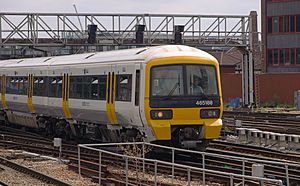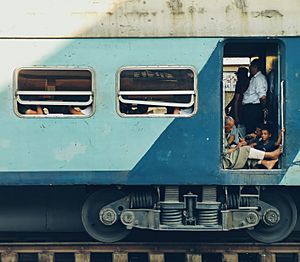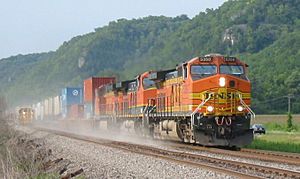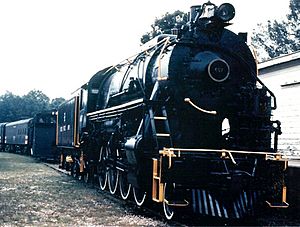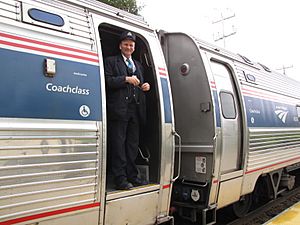Train facts for kids
A train is a group of connected vehicles that travel along a special track called a railway. Imagine a long line of cars linked together, moving on rails! A place where a train stops for people to get on and off is called a train station.
Long ago, the first trains were pulled by horses on wooden or iron tracks. This was way back in the Middle Ages. The very first trains powered by steam engines were built in England in the early 1800s. Before railways even existed, the word "train" just meant any group of vehicles or animals traveling in a line, like a wagon train or a camel train.
Trains usually have a special engine, called a locomotive, that pulls the other cars. This engine is often at the front. The very last car you might see on some trains is called a caboose. Some trains are designed like a special bus that can only drive on rails. Trains are super useful for carrying both people and all sorts of cargo, like raw materials, finished products, and even waste.
Contents
Different Kinds of Trains
Freight Trains
Freight trains are made up of special cars designed to carry goods from one place to another. Some of these cars are boxcars, which are closed and have roofs, perfect for protecting cargo. Other cars are built for specific types of cargo.
For example, there are:
- Hopper cars for carrying sand, coal, ore, and other materials that are like sand.
- Flatbed cars for vehicles and large machines.
- Tank cars for liquids.
- Container cars for large containers.
- Even special bottle cars for carrying hot, melted iron!
Almost anything that isn't too big to fit under tunnels and bridges can be moved on these special freight cars.
Passenger Trains
Passenger trains have special cars where people can ride from one train station to another. There aren't many long-distance passenger trains in the United States, but they are very common in Europe and Asia. Most passenger cars have one level, but some, like those in Finland, have two levels!
Traveling by passenger train can be very comfortable. Many modern trains have electrical outlets and Wi-Fi hotspots so you can use your computers and phones. There are often special restaurant cars where you can buy food and drinks. For long trips overnight, some trains even have sleeping cars with beds!
High-speed rail uses very fast passenger trains that run on special tracks. A few super-fast trains are called maglev trains. They use strong magnets to float slightly above the tracks, which helps them go even faster because there's less rubbing (friction).
Who Works on a Train?
- The driver or engineer is in charge of making the train move. They control its speed, making it go faster or slower. Every train needs a driver to operate correctly.
- The guard or conductor makes sure the train is on the right path and helps the driver if needed. They also often check tickets and help passengers.
- Only old steam trains have a fireman. This person's job was to make sure the fire that powered the steam engine kept burning by adding coal to it.
How Trains Move
Most trains are pulled by separate engines called locomotives. Before the 1900s, almost all trains used steam locomotives. But steam engines used a lot of fuel. So, starting in the 1930s, trains began to switch to diesel locomotives and electric locomotives. Today, many locomotives are diesel-electric locomotives, which use a diesel engine to generate electricity for the motors that turn the wheels.
Sometimes, a train doesn't have a separate locomotive. Instead, the engine (either a diesel engine or an electric motor) is built right into the first car of the train. This car also has the driver's cabin and is called a "motor unit." Some trains even have motors in many or all of their cars. These are called diesel multiple units or electric multiple units. Often, these trains have driver's cabins at both ends, which is great for commuter trains in big cities because they don't need to turn around. Electric trains get their power from a special "third rail" next to the track or from overhead wires.
Images for kids
-
A Union Pacific intermodal freight train in Arizona, U.S.
-
Arrival of the Normandy Train, Gare Saint-Lazare, by Claude Monet, 1877, Art Institute of Chicago
-
Interior of a passenger car in a long-distance train in Finland
-
The Shinkansen N700 Series Nozomi travels between Tokyo and Osaka in around two and a half hours.
-
The Electric Tilt Train, the fastest train in Australia, operates between Brisbane and Rockhampton in Queensland, a distance of 615 km.
-
A "tube train" on the London Underground
-
An Aurizon freight train in Fremantle, Western Australia
-
Swiss Electric locomotive at Brig, Switzerland
See also
 In Spanish: Tren para niños
In Spanish: Tren para niños


